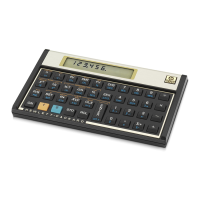168 Appendix A: RPN and the Stack
Termination of Digit Entry
The first digit keyed in after digit entry has been terminated replaces the number
already in the displayed X-register. Digit entry is automatically terminated when
any key is pressed (except for digit entry keys – digit keys,., Þ, and É –
and prefix keys – f, g,?, :, and i).
Stack Lift
When the stack lifts, the number in each stack register is copied into the register
above, and the number formerly in the T-register is lost. The number formerly in
the X-register is then contained in both the X-register and the Y-register.
When a number is entered into the displayed X-register – either from the key-
board, from a storage register (using:), or from the LAST X register (using
F) – the stack usually lifts first. The stack does not lift if the last key pressed
before a number is entered was one of the following: \, O, _, ^, A
or C.
1
If one of these keys was the last key pressed, the number in the dis-
played X-register is replaced when a new number is entered.
Rearranging Numbers in the Stack
The ~ Key
Pressing ~ exchanges the numbers in the X- and
Y-registers.
Certain functions (Ò, Ï, !, E, V,
Ý, #, Ö, v, R, and Q) return answers to
the Y-register as well as to the displayed X-register. The ~ key, since it
exchanges the number in the Y-register with that in the displayed X-register, is
used to display the second number calculated.
The d Key
When d (roll down) is pressed, the number in each
stack register is copied into the register below, and
the number formerly in the X-register is copied into
the T-register.
1.
In addition, the stack does not lift when a number is entered if the last operation performed
was storing a number into a financial register. For example, the stack will not lift when a
number is entered following the sequence 100000$, but will lift when a number is entered
following the sequence 100000$M. Note also that although the stack lifts when \ is
pressed, it does not lift when a number is entered after \ is pressed.

